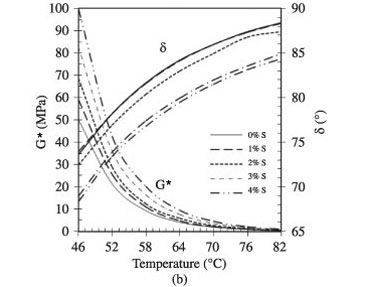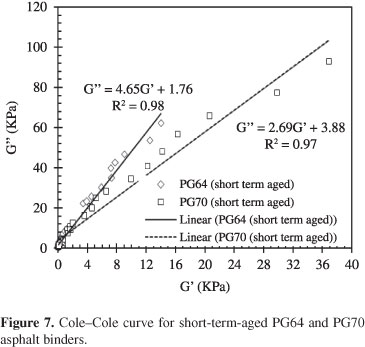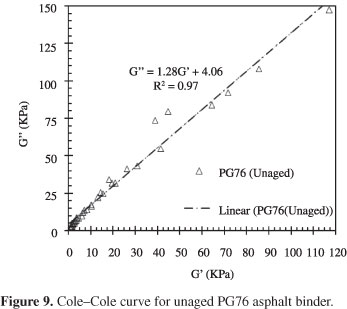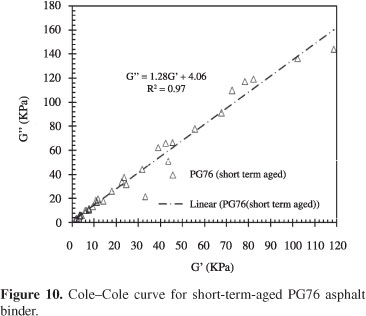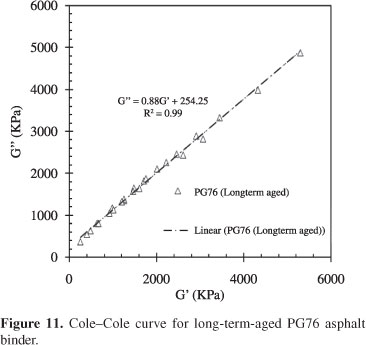Abstract
This paper describes the rheological properties of PG64, PG70, and PG76 asphalt binders blended with different Sasobit® contents. The rheological properties of the Sasobit®-modified binders were characterized after being subjected to different aging conditions using the dynamic shear rheometer (DSR) and rotational viscometer (RV) according to SuperpaveTM test protocols. The results indicated that the characterization of aging in terms of the Aging Index (AI) depends on the rheological property of the asphalt binder selected for use in evaluating aging, the amount of Sasobit®, the binder type, and the temperature range. Linear relationships between failure temperatures of unaged and short-term-aged asphalt were observed for three binder types. Design charts were developed to select the appropriate Sasobit® content as a function of temperature, taking into consideration the stiffening effects of Sasobit®, using the SuperpaveTM fatigue factor and asphalt mix construction temperatures.
Sasobit®; rheology; aging index; loss modulus; storage modulus
Effects of Sasobit® content on the rheological characteristics of unaged and aged asphalt binders at high and intermediate temperatures
Ali Jamshidi, Meor Othman Hamzah* * e-mail: cemeor@eng.usm.my ; Mohamad Yusri Aman
School of Civil Engineering, Universiti Sains Malaysia - USM, Engineering Campus,14300 Nibong Tebal, Seberang Perai Selatan, Penang, Malaysia
ABSTRACT
This paper describes the rheological properties of PG64, PG70, and PG76 asphalt binders blended with different Sasobit® contents. The rheological properties of the Sasobit®-modified binders were characterized after being subjected to different aging conditions using the dynamic shear rheometer (DSR) and rotational viscometer (RV) according to SuperpaveTM test protocols. The results indicated that the characterization of aging in terms of the Aging Index (AI) depends on the rheological property of the asphalt binder selected for use in evaluating aging, the amount of Sasobit®, the binder type, and the temperature range. Linear relationships between failure temperatures of unaged and short-term-aged asphalt were observed for three binder types. Design charts were developed to select the appropriate Sasobit® content as a function of temperature, taking into consideration the stiffening effects of Sasobit®, using the SuperpaveTM fatigue factor and asphalt mix construction temperatures.
Keywords: Sasobit®, rheology, aging index, loss modulus, storage modulus
1. Introduction
In recent years, the prices of carbon-based energy carriers, particularly crude oil, have substantially increased due to concerns about the long-term availability of fossil fuels as energy resources. Although it is difficult to forecast when fossil fuels will be totally depleted, some are of the opinion that the peak point in oil production occurred in the year 20101-3. The two prevailing strategies by which the energy sectors in many countries are trying to cope with this problem are the following: searching for inexhaustible and non-polluting new energy sources and generating cleaner production of energy by the development of low-carbon technologies. The challenges of the first strategy are clear: new infrastructure for the production and distribution of new energy sources needs to be constructed, while costs must decrease significantly. Even if new non-polluting energy sources are found, it will be many years before they can be produced on a large industrial scale. The second strategy affords energy producers to achieve results within a shorter period of time. The asphalt industry also needs to abide by environmental restrictions. In asphalt plants, asphalt mixes are typically produced at 160 °C. Hence, a significant proportion of the cost of asphalt mix production is associated with supplying the energy needed to raise the aggregate and binder temperatures to the mixing point. The escalating price of crude oil and, as a consequence, the escalating price of asphalt binders has stimulated efforts to reduce asphalt production temperatures and improve the sustainability of asphalt mix production. Lowering the production temperatures of asphalt mixes saves energy, reduces costs, and reduces carbon emissions. Since the adoption of the Kyoto protocol, global efforts have been made to modify energy consumption practices in accordance with more stringent environmental guidelines, to limit production of greenhouse gases, and reduce consumption of petroleum products. Among the many studies that have been conducted to address these issues are studies on the use of renewable natural resources and synthetic adhesive binders as replacements for asphalt binders4-7.
Another method that has gained popularity within the asphalt industries is the use of warm-mix asphalt (WMA). This technology reduces greenhouse gas emission and energy consumption by lowering the production and paving temperatures of asphalt mixes8. With WMA, suitable binder viscosities can be attained at lower temperatures than with conventional hot-mix asphalt (HMA). This results in reduced energy consumption and reduced emissions, fumes and, odor at asphalt mixing plants and paving sites9. The reduced energy consumption associated with WMA also reduces the costs of asphalt pavement construction.
One of the materials that have been used in the production of WMA is a type of synthetic wax named Sasobit®, an asphalt binder additive produced from Fischer-Tropsch (FT) paraffin wax. The effects of a wax additive on asphalt binder depend on the amount of wax, its chemical composition, and its crystalline structure, as well as the rheological properties of the binder10,11.
Sasobit® has been used as to improve asphalt flow by reducing binder viscosity. The main reason for adding Sasobit® to asphalt binder is to decrease the mixing and compaction temperatures of asphalt mixes without sacrificing mix properties. Various studies on asphalt binder have shown that Sasobit® increases the SuperpaveTM rutting factor (G*/sin d), zero shear viscosity (ZSV) and stiffness of asphalt binders12-16. Sasobit® can be used in conjunction with other additive materials such as crumb rubber. Addition of Sasobit® also increased the binder viscosity at 60 °C and the complex modulus at low temperatures and high frequencies, compared to asphalt binders modified by crumb rubber17. The experimental results indicated that asphalt binders extracted from Sasobit® WMA had lower G*/sin d values than binders extracted from conventional HMA18. This implies that the lowered construction temperatures of WMA significantly decreased aging in the binder.
However, little or no information is available in the literature on the relationship of Sasobit® content to the rheological properties of various asphalt binder types at different aging states and temperature ranges. Furthermore, because different aging indexes can be defined based on different rheological properties of the asphalt binder, there has been no detailed study of the effects of Sasobit® content on aging index (AI) and related trends at high and intermediate temperatures for different binder types. Therefore, the main objective of this paper is to characterize the rheological properties of various asphalt binders blended with different Sasobit® contents under unaged and aged conditions in terms of aging index, using current SuperpaveTM asphalt binder tests.
2. Materials and Test Programs
2.1. Materials
2.1.1. Asphalt binder
Three conventional asphalt binders, PG64, PG70, and PG76 (polymer modified binder), were used in this study. The effect of source of asphalt binder was not addressed in this study because the asphalt binders were only available from one source. Table 1 summarizes the rheological properties of the binders.
2.1.2. Sasobit®
The Sasobit® used was supplied by Sasol Wax, South Africa (Figure 1). The percentage of Sasobit® used in the experiment ranged from 1% to 4% at 1% increments by mass of the asphalt binder. Table 2 shows the physical properties of Sasobit®.
2.2. Test programs
2.2.1. Preparation of Sasobit®-modified binder
The required proportions of Sasobit® and binder were blended in an electrical propeller mixer at 140 °C for 30 minutes. For equivalent simulation of aging conditions, the control binder sample (without Sasobit®) was also heated at the same temperature for 30 minutes.
2.2.2. Asphalt binder aging
All asphalt binder samples were subjected to short-term and long-term aging by artificially conditioning them in the laboratory via the rolling thin-film oven (RTFO) and pressure aging vessel (PAV), respectively, in accordance with the procedures outlined in ASTM D2872 (2004)21 and ASTM D6521 (2004)22, respectively.
2.2.3. Dynamic shear rheometer
According to Specht (2008)23, rheology is the study of the characteristics of fluid and semi-solid materials and the relationships of force and time to deformation in these materials. The complex shear modulus (G*) is one of the most important rheological characteristics of viscoelastic materials. In this study, the effects of Sasobit® content on the rheological characteristics of unaged and aged warm binder samples at intermediate temperatures were investigated in terms of G* and the phase angle (δ) determined from the Dynamic Shear Rheometer (DSR) test. Temperature sweeps were applied from 46 °C to 82 °C at 6 °C increments for unaged and short-term-aged samples in accordance with SuperpaveTM requirements24. For long-term-aged samples, temperature sweeps were applied from 16 °C to 31 °C, 19 °C to 34 °C, and 25 °C to 37 °C, at 3 °C increments, for PG64, PG70, and PG76 samples, respectively. The test sample diameter and thickness were 25 mm and 1 mm, respectively, for the unaged and short-term-aged samples, while the corresponding values for the long-term-aged samples were 8 mm and 2 mm, respectively. The loading frequency sweep applied, in accordance with SuperpaveTM requirements, was 1.59 Hz or 10 rad/s, a frequency of oscillation that simulates the shear stress corresponding to a traffic speed of approximately 100 km/h.
2.2.4. Brookfield rotational viscometer
The Aging Index at elevated temperatures (120 °C to 160 °C at 10 °C increments) was evaluated using a Brookfield rotational viscometer (RV). Figure 2 illustrates the flow chart of the experimental design. Three readings were recorded for each test, and the mean value was recorded as the final result.
3. Result and Discussion
3.1. Effects of Sasobit® content on viscoelastic properties of asphalt binder
The effects of Sasobit® on asphalt binder G* and d versus temperature for unaged and aged conditions are illustrated in Figures 3, 4, and 5 (master curve). As Figures 3, 4, and 5 shows, Sasobit® increases G* and decreases d of the binder samples regardless of aging condition and binder type. This occurs because the lattice crystalline structure formed in the Sasobit®-modified binder reduces temperature sensitivity and increases the elasticity of the binder9,13,17. In the other words, Sasobit® has two difference performance based on temperature. At the temperatures higher than Sasobit® melting point at hot asphalt binder, it reduces asphalt binder viscosity, while at intermediate temperature, it increases the binder stiffness via lattice crystalline formed in the modified binder10,12,25.
Figures 3a, b, d, e show that the phase angle and the complex shear modulus follow similar trends with temperature (power and polynomial trends for complex modulus and phase angle, respectively, with R2 of 98%) before and after aging. Figures 3c, 4c, and Figures 5c illustrate the linear relationship between phase angle and temperature, with R2 of 90%, and an exponential trend for complex modulus, for long-term aging conditions. This is because asphalt binders have less temperature susceptibility after long-term aging, a characteristic that is enhanced by the addition of Sasobit®. In addition, the DSR tests on the long-term-aged samples were conducted at lower temperatures than those at which the unaged and the short-term-aged samples were tested.
Figures 6 to 11 illustrate the Cole -Cole curve of the relationship between the elastic or storage modulus (G") and the viscous or loss modulus (G") of the binder containing Sasobit®. The Cole -Cole curve is suggested to validate the test data for a master curve at any frequency or temperature17. The acceptable data are independent of temperature and frequency and form a single curve. As illustrated in Figures 6 to 11 the relationships between G' and G" are linear and form single curve with R2 equal or greater than 95%, for all of the binder samples and aging conditions considered, regardless of Sasobit® content or binder type. This implies that the data from the master curves illustrated in Figures 3, 4, and 5 are valid.
3.2. Effects of Sasobit® content on rutting
According to SuperpaveTM, rutting is controlled by limiting the G*/sin d at a designated test temperature to a value greater than 1.0 kPa for unaged binders or 2.2 kPa for short-term-aged binders24. Figure 12 shows the effects of Sasobit® content on the SuperpaveTM rutting parameter of both unaged and short-term-aged binders at various temperatures.
As anticipated, the addition of Sasobit® increases G*/sin d for both unaged and short-term-aged binders. The effects of Sasobit® content on binder performance grading can be evaluated using the rutting factor. The results show that 1% Sasobit® has no effect on the performance grading of PG64 binder, while 4% Sasobit® increases its performance grading to PG70. For PG70 binder, 2% Sasobit® increases its performance grading to PG73, while 3% and 4% Sasobit® increase its performance grading to PG74 and PG76, respectively. After short-term aging, the high failure temperature characteristics of the Sasobit®-modified and control samples were determined, and the results obtained are presented in Figure 13.
3.3. Effects of Sasobit® content on aging
Asphalt binder aging is a complex physicochemical phenomenon. Asphalt binder is aged considerably by its first exposure to the burner in an asphalt plant and by contact with hot aggregates, throughout hauling, paving, and compaction26. Aging is primarily caused by two mechanisms, namely, oxidation by reaction with oxygen in the environment and volatilization of light oils24. During aging, resins turn into asphaltenes and affect the elastic solid behavior of asphalt binder27. Because the chemical structure of asphalt binder is complex28,29, aging in asphalt binder, particularly in a modified asphalt binder, may be more complex. The extent of aging is evaluated in terms of an Aging Index (AI), which is defined as a ratio between a rheological property of an aged binder and the same rheological property of the binder when unaged30 (Equation 1).
The rheological property adopted to determine an AI depends on the aged property of interest. In addition, the test temperature may vary, depending on the rheological property selected for use in determining the AI. For example, an experimental study used the ratio of aged to unaged binder G*/sin d for binders tested at intermediate temperatures15, while the other studiesused viscosity to characterize binder aging at high temperatures31,32. In the study described in this paper, AI values were computed based on viscosity and G*/sin d, for evaluation at high and intermediate temperature ranges, respectively. AI results may differ widely, depending on the binder type, Sasobit® content, and temperature sweep (high or intermediate temperatures) chosen, as the analysis of variance results shown in Table 3 indicate. Tables 4 and 5 show the resultant AI based on viscosity and G*/sin d, respectively.
The AI values based on G*/sin d (Table 5) are greater than those based on viscosity (Table 4) for each Sasobit® content, irrespective of temperature ranges. This occurs because aged binder is stiffer at intermediate temperatures than at high temperatures.
Four different trends can be observed from the results shown in Table 4. In some cases, AI decreases with increasing test temperature (compare, for example, the control PG 70 with 0% Sasobit® and the PG70 with 1% and 2% Sasobit®).
In other cases, AI decreases with test temperature up to a point and then increases. For instance, the AI of the control PG64 decreases from 120 °C to 150 °C, but is higher at 160 °C than at 150 °C. The PG64 binder with 3% Sasobit®, the PG70 with 3% and 4% Sasobit®, and the PG76 with 2% Sasobit® all follow this trend, although their AI values decrease at different temperatures.
In other cases, AI decreases with increasing test temperature but increases at two particular temperatures. The PG64 binder samples with 1%, 2% and 4% Sasobit® exhibit this trend. Although the amounts by which AI decreases and increases can be negligible, they are evident in the trends.
Another trend that is observed only for PG76 is an increase in AI with increasing test temperature up to 130 °C and a decrease in AI beyond 130 °C. The control PG76 and the PG76 samples containing 1%, 3%, and 4% all follow this trend. Although the increase in AI may not be significant, it clearly indicates that analysis of AI can be very complicated because of the interactions among binder type, test temperature, and Sasobit® content (Table 3).
The first and second trends observed in Table 4 can be seen in Table 5 but at different Sasobit® contents and temperatures. Table 5 shows that AI increases for PG64 samples with 1% and 2% Sasobit® from 46 °C to 58 °C, compared to the control sample, while AI decreases with 3% and 4% Sasobit® over the same temperature range. In the case of PG70, the increasing AI trend from 46 °C to 64 °C is changed to a decreasing trend from 70 °C to 82 °C for all Sasobit® contents. This indicates that the trend in AI is dependent on temperature, Sasobit® content and binder type.
In the case of PG76, AI decreases as Sasobit® increases from 46 °C to 76 °C, the maximum AI being observed for the control PG76 (with 0% Sasobit®) over this temperature range. The maximum AI values observed for PG76 samples incorporating 1% Sasobit® at 82 °C. A similar trend can be seen for the other asphalt binders but for various Sasobit® content and test temperatures. The increases or decreases in AI for asphalt binders with different amounts of Sasobit® can exhibit trends with temperature for high and intermediate temperatures ranges. The observed trends can be useful for comparing the performance of different types of warm binder additives and the effects of binder type and temperature on AI.
Because lower AI values are more desirable (lower AI indicating less stiffness after aging15, the results shown in Table 5 indicate that the most appropriate Sasobit® content, based on AI defined in terms of G*/sin d, are 4% and 2% for PG64 and PG76, respectively, at a test temperature of 46 °C, while the most appropriate Sasobit® content for PG70 at the same test temperature is 1%.
The results shown in Table 4, on the other hand, indicate that the most appropriate Sasobit® content, based on AI defined in terms of viscosity, is 4% for PG64 and PG70 but is 2% for PG76, all at 130 °C. These differences in the appropriate Sasobit® content depending on whether AI is defined in terms of G*/sin d or viscosity illustrate the effect that the rheological property selected for evaluation of AI has on the results.
It is evident that selection of incorrect rheological properties (viscosity and G*/sin d) and test temperatures can lead to misleading results in the characterization of aging not only for asphalt binders containing Sasobit® but also for control samples. Therefore, the asphalt binder rheological property and test temperature used to evaluate AI should be selected with care.
3.4. Selection of appropriate percentage of Sasobit®
Higher Sasobit® contents can decrease the viscosity and G*/sin d but increase the SuperpaveTM fatigue factor (G* sin d) of asphalt binders. There is a limit to the amount of Sasobit® that can be added to an asphalt binder, because a higher G* sin d can make the binder more prone to fatigue and cracking, especially at intermediate and low temperatures12,18. Therefore, it is necessary to balance the performance of Sasobit®-modified binders at high, intermediate and low temperatures. A value of no more than 5 MPa is suggested for the SuperpaveTM fatigue factor (G* sin d). This can be used as a guide to establish a limit for Sasobit® content at intermediate temperatures, while the required mixing and compaction temperatures can be used to evaluate the performance of Sasobit®-modified binders at high temperatures. The Asphalt Institute recommends mixing and compaction temperatures corresponding to viscosity ranges of 170 ± 20 MPa.s and 280 ± 30 mPa.s, respectively33, for PG64 and PG70. While recommend viscosities of 275 MPa.s and 550 MPa.s at a shear rate of 500 s-1 are recommended to determine appropriate mixing and compaction temperatures for polymer modified asphalt binders34, respectively, which was used for PG76.
Figures 14 and 15 are charts that can be used to select the appropriate Sasobit® content based on a Sasobit®-modified binder's rheological properties at intermediate and high temperatures. The areas below the dashed lines in Figures 14 and 15 are desirable in terms of resistance to fatigue. Although Sasobit® reduced PG76 viscosity, it did not reduce construction temperatures based on the criteria recommended for PG76. Therefore, it is suggested that the other criteria be adopted to determine the construction temperature for Sasobit®-modified PG76 using the rotational viscometer.
Figures 14 and 15 indicate that Sasobit® can be added up to 1.6% in asphalt binder without adversely affecting pavement performance at the lowest temperature of 19 °C and 27 °C for PG64 and PG70 binders, respectively. This value is very close to the 1.5% Sasobit® content recommended in the USA35. The mixing and compaction temperatures for PG64 with 1.6% Sasobit® are 154 °C and 144 °C, respectively, while the corresponding values for PG70 are 157 °C and 146 °C, respectively, according to the Asphalt Institute's viscosity recommendations.
Figures 14 and 15 also illustrate the trend of construction temperatures (mixing and compaction) decreasing as Sasobit® content increases. For PG70, the mixing and compaction temperatures for samples with 3% and 4% Sasobit® are similar, while the corresponding temperatures decrease for PG64 at the same Sasobit® content. Therefore, the maximum effective Sasobit® content is 4% for PG64 and 3% for PG70. This indicates that the trend of the effect of Sasobit® content in reducing construction temperatures is dependent on binder type.
Although a higher Sasobit® content can potentially reduce mixing and compaction temperatures, it can also reduce resistance to fatigue. Two mitigation measures can be considered. The first is the use of a lower Sasobit® content in the asphalt binder, and the second is the use of a low-viscosity virgin binder. An experimental study showed that the use of low-viscosity virgin asphalt binder was effective in mitigating the increase in asphalt binder stiffness due to WMA additives in long-term-aged binders36.
4. Conclusions
Several conclusions can be drawn from the experimental results obtained from this study. The magnitude and trend in AI depend primarily on the binder rheological property used to evaluate AI, Sasobit® content, binder type and test temperature range. Using AI to evaluate the effects of aging on the characteristics of asphalt binder containing Sasobit® is complicated since it depends on many variables such as binder type, test temperature range and Sasobit® content. Design charts were developed to select the appropriate Sasobit® contents using the SuperpaveTM fatigue parameter, G* sin d, and construction temperatures based on ideal viscosities recommended by the Asphalt Institute. The design charts show that Sasobit® can be added to PG64 and PG70 binders up to 1.6% without affecting fatigue resistance. Similar design charts can be developed for other binder types to select the appropriate Sasobit® contents without adversely affecting fatigue resistance.
Acknowledgements
The authors would like to acknowledge the Universiti Sains Malaysia (USM) that has funded this research through the Research University grant scheme that enables this paper to be written. Many thanks are also due to technicians of the Highway Engineering Laboratory at the University Sains Malaysia.
Received: August 24, 2011
Revised: May 7, 2012
- 1. Almeida PD and Silva PD. The peak of oil production - Timings and market recognition. Journal of Energy Policy 2009; 37(4):1267-1276. http://dx.doi.org/10.1016/j.enpol.2008.11.016
- 2. Aleklett K. Reserve driven forecasts for oil, gas, coal and limits in carbon dioxide emissions. In: Proceedings of the International Transport Forum; 2007; Uppsala. Uppsala University; 2007. p. 1-20.
- 3. Armstrong F, Blundell K and Fells L. Energy beyond oil: a global perspective. Oxford: University press; 2007. p. 1-7.
- 4. Airey GD, Mohammad MH and Caroline F. Rheological characteristics of synthetic road binders. Fuel Journal 2008; 87(10):1763-1775. http://dx.doi.org/10.1016/j.fuel.2008.01.012
- 5. Emengo FN, Chukwu SER and Mozie J. Tack and bonding strength of carbohydrate-based adhesives from different botanical sources. International Journal Adhesion and Adhesive 2002; 22(2):93-100. http://dx.doi.org/10.1016/S0143-7496(01)00025-2
- 6. Tsujimoto T, Uyama H and Kobayashi S. Synthesis and curing behaviors of cross-linkable polynaphthols from renewable resources: preparation of artificial urushi. Macromolecules 2004; 37(5):1777-1782. http://dx.doi.org/10.1021/ma035271j
- 7. Uyama H, Kuwabara M, Tsujimoto T and Kobayashi S. Enzymatic synthesis and curing of biodegradable epoxide-containing polyesters from renewable resources. Biomacromolecules 2003; 4(2):211-215. PMid:12625714. http://dx.doi.org/10.1021/bm0256092
- 8. Kristjonesdottir O, Muench ST, Michael L and Burke G. Assessing potential for warm-mix asphalt technology adoption. Transportation Research Record: Journal of the Transportation Research Board. 2007; 2040:91-99. http://dx.doi.org/10.3141/2040-10
- 9. Hurley G and Prowell B. Evaluation of Sasobit® for use in warm mix asphalt Auburn; 2005. p. 1-27. NCAT report number 05-06.
- 10. Edwards Y and Isacsson U. Wax in bitumen. Part I-Classifications and general aspects. Journal of Road Materials and Pavement Design 2005; 6(3):281-309. http://dx.doi.org/10.1080/14680629.2005.9690009
- 11. Edwards Y and Isacsson U. Wax in bitumen. Part II-Characterizations and effects. Journal of Road Materials and Pavement Design. 2005; 6(4):439-468. http://dx.doi.org/10.1080/14680629.2005.9690015
- 12. Kim H, Lee SJ and Amirkhanian SN. Effects of warm mix asphalt additives on performance properties of polymer modified asphalt binders. Canadian Journal of Civil Engineering 2010; 37(1):17-24. http://dx.doi.org/10.1139/L09-118
- 13. Biro S, Gandhi T and Amirkhanian SN. Determination of zero shear viscosity of warm asphalt binders. Journal of Construction and Building Materials 2009; 23(5):2080-2086. http://dx.doi.org/10.1016/j.conbuildmat.2008.08.015
- 14. Kanitpong K, Nam K, Martono W and Bahia H. Effects of a warm-mix additive. Journal of Institution of Civil Engineers 2008; 161(CM1):1-8.
- 15. Wasiuddin NM, Selvamohan S, Zaman MM and Guegan MLTA. Comparative laboratory study of Sasobit® and aspha-min additives in warm mix asphalt. Transportation Research Record: Journal of the Transportation Research Board. 2007; 1998:82-88.
- 16. Edwards Y, Tasdemir Y and Isacsson U. Rheological effects of commercial waxes and polyphosphoric acid in bitumen 160/220 - high and medium temperature performance. Journal of Construction and Building Material 2007; 21(10):1899-1908. http://dx.doi.org/10.1016/j.conbuildmat.2006.07.012
- 17. Akisetty CK, Gandhi T, Lee SJ and Amirkhanian SN. Analysis of the rheological properties of rubberized binders containing warm asphalt additives. Canadian Journal of Civil Engineering 2010; 37(5):763-771. http://dx.doi.org/10.1139/L10-020
- 18. Gandhi T and Amirkhanian SN. Laboratory simulation of warm mix asphalt (WMA) binder aging characteristics. Journal of American Society of Civil Engineering 2008; 195-204. http://dx.doi.org/10.1061/41005(329)17
- 19. Sasol Wax. Product data sheet Division of Sasol Chemical Industries Limited; 2007.
- 20. Sellers BH. Characterization and transition of asphalt cement composite materials [Dissertation]. Charlotte: University of North Carolina; 2009.
-
21American Society for Testing and Materials - ASTM. ASTM D2872: Standard test method for effect of heat and air on moving film of asphalt (Rolling Thin-Film Oven Test). ASTM; 2004.
-
22American Society for Testing and Materials - ASTM. ASTM D6521: Standard practice for accelerated aging of asphalt binder using a Pressurized Aging Vessel (PAV). ASTM; 2008.
- 23. Specht LP, Khatchatourian O, Brito LAT and Ceratti JAT. Modeling of asphalt-rubber rotational viscosity by statistical analysis and neural networks. Material Research 2007; 10(1):69-74. http://dx.doi.org/10.1590/S1516-14392007000100015
- 24. Asphalt Institute. Superpave Mix Design. 3rd ed. Lexington; 2001. Superpave Series, no. 2 (SP-1).
- 25. Akisetty CK, Lee SJ and Amirkhanian SN. High temperature properties of rubberized binders containing warm asphalt additives. Journal of Construction and Building Materials 2009; 23(1):565-573.
- 26. Shaleby A. Modeling short-term aging of asphalt binders using the rolling thin film oven test. Canadian Journal of Civil Engineering. 2002; 29(1):135-144. http://dx.doi.org/10.1139/l01-086
- 27. Rajan NK, Selvavathi V, Sairam B and Krishnan JM. Influence of asphaltan on the rheological properties of blended paving asphalts. Journal of Petrolium Science and Technology 2010; 28(4):331-350.
- 28. Fernandes MRS, Forte, MMC and Leite LFM. Rheological evaluation of polymer-modified asphalt binders. Material Research 2008; 11(3):381-386. http://dx.doi.org/10.1590/S1516-14392008000300024
- 29. Lu X and Issacson U. Effect of ageing on bitumen chemistry and rheology. Journal of Construction and Building Materials 2002; 16(1):15-22.
- 30. Apeagyei A. Laboratory evaluation of antioxidants for asphalt binders. Journal of Construction and Building Materials 2011; 25(1):47-53.
- 31. Gandhi T, Akisetty C and Amirkhanian S. Laboratory evaluation of warm asphalt binder aging characteristics. International Journal of Pavement Engineering 2009; 10(5):353-359. http://dx.doi.org/10.1080/10298430802342724
- 32. Roberts FL, Kandhal PS, Brown ER, Lee DY and Kennedy TW. Hot mix asphalt materials, mixture design, and construction 2nd ed. NAPA: Research and Education Foundation; 1996.
- 33. Asphalt Institute. Superpave Mix Design. 3rd ed. Lexington; 2001. Superpave Series, no. 2 (SP-2).
- 34. Yildirim Y, Ideker J and Hazlett D. Evaluation of viscosity values for mixing and compaction temperatures. Journal of Materials in Civil Engineering. 2006; 18(4):545-553. http://dx.doi.org/10.1061/(ASCE)0899-1561(2006)18:4(545)
- 35. D'Angelo J, Harm E, Bartoszek J, Baumgardner G, Corrigan M, Cowsert J et al.Warm-Mix Asphalt: European Practice. 2008. FHWA-PL-08-007.
- 36. Lee SJ, Amirkhanian SN, Park NW and Kim KW. Characterization of warm mix asphalt binders containing artificially long-term aged binders. Journal of Construction and Building Materials 2009; 23(7):2371-2379
Publication Dates
-
Publication in this collection
31 July 2012 -
Date of issue
Aug 2012
History
-
Received
24 Aug 2011 -
Reviewed
07 May 2012




